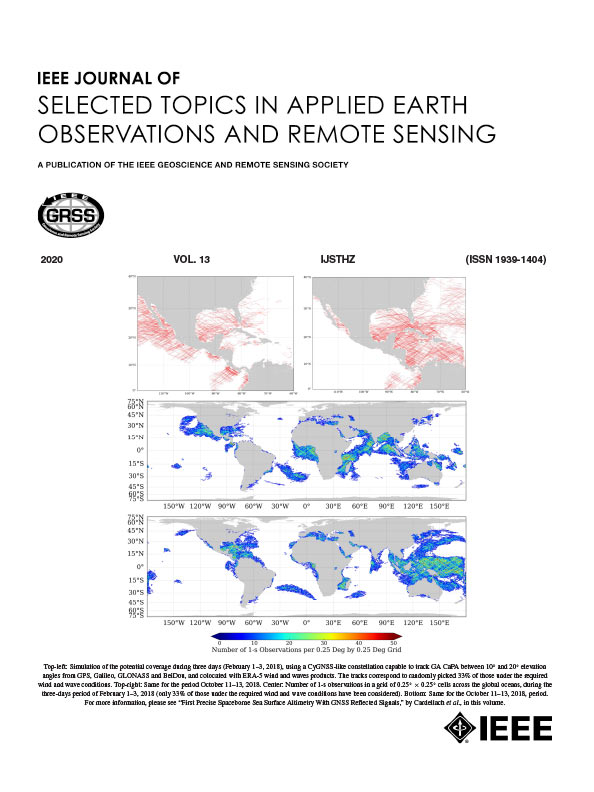Micro-Doppler Frequency Extraction and Scatterer Classification for a Smooth-Surfaced Cone-Shaped Precession Target Under Narrowband Radar
IF 4.7
2区 地球科学
Q1 ENGINEERING, ELECTRICAL & ELECTRONIC
IEEE Journal of Selected Topics in Applied Earth Observations and Remote Sensing
Pub Date : 2025-03-26
DOI:10.1109/JSTARS.2025.3555068
引用次数: 0
Abstract
The micro-Doppler (μD) characteristics of ballistic targets are crucial for estimating motion and structural parameters, as well as for target recognition. However, existing time-frequency (TF) analysis methods are predominantly nonparametric and suffer from limited resolution, making it challenging to accurately extract μD TF curves. This limitation hampers further applications in this domain. Therefore, under narrowband radar observation conditions, this article proposes a method for μD TF characteristics extraction and scatterer type identification, specifically for smooth-surfaced cone-shaped precession targets. The method first utilizes sliding-window Root-MUSIC to extract the instantaneous μD frequencies of the target. Then, the inverse Radon transform (IRT) and You Only Look Once version 5 algorithm are applied to locate and identify the peaks of cone vertex and cone base after IRT. Based on the peaks, the μD TF trend curves can be reconstructed using the Radon transform (RT). The extracted instantaneous μD frequencies are then associated according to the trend curves, enabling the reconstruction of the μD frequencies for the cone vertex and cone base. Experiments validate the effectiveness and noise robustness of the proposed method. The results demonstrate that the estimation accuracy of the proposed method is independent of the sampling interval and significantly outperforms traditional nonparametric methods.窄带雷达下光滑锥面进动目标的微多普勒频率提取与散射体分类
弹道目标的微多普勒(μD)特性对弹道目标的运动和结构参数估计以及目标识别至关重要。然而,现有的时频(TF)分析方法主要是非参数的,且分辨率有限,难以准确提取μD TF曲线。这一限制阻碍了该领域的进一步应用。因此,在窄带雷达观测条件下,本文提出了一种针对光滑表面锥形进动目标的μD TF特征提取和散射体类型识别方法。该方法首先利用滑动窗口Root-MUSIC提取目标的瞬时μD频率;然后,利用Radon逆变换(IRT)和You Only Look Once version 5算法对IRT后的锥顶点和锥底的峰值进行定位和识别。在此基础上,利用Radon变换(RT)重构μD - TF趋势曲线。然后根据趋势曲线将提取的瞬时μD频率进行关联,从而重建锥体顶点和锥体基部的μD频率。实验验证了该方法的有效性和噪声鲁棒性。结果表明,该方法的估计精度与采样间隔无关,显著优于传统的非参数方法。
本文章由计算机程序翻译,如有差异,请以英文原文为准。
求助全文
约1分钟内获得全文
求助全文
来源期刊
CiteScore
9.30
自引率
10.90%
发文量
563
审稿时长
4.7 months
期刊介绍:
The IEEE Journal of Selected Topics in Applied Earth Observations and Remote Sensing addresses the growing field of applications in Earth observations and remote sensing, and also provides a venue for the rapidly expanding special issues that are being sponsored by the IEEE Geosciences and Remote Sensing Society. The journal draws upon the experience of the highly successful “IEEE Transactions on Geoscience and Remote Sensing” and provide a complementary medium for the wide range of topics in applied earth observations. The ‘Applications’ areas encompasses the societal benefit areas of the Global Earth Observations Systems of Systems (GEOSS) program. Through deliberations over two years, ministers from 50 countries agreed to identify nine areas where Earth observation could positively impact the quality of life and health of their respective countries. Some of these are areas not traditionally addressed in the IEEE context. These include biodiversity, health and climate. Yet it is the skill sets of IEEE members, in areas such as observations, communications, computers, signal processing, standards and ocean engineering, that form the technical underpinnings of GEOSS. Thus, the Journal attracts a broad range of interests that serves both present members in new ways and expands the IEEE visibility into new areas.

 求助内容:
求助内容: 应助结果提醒方式:
应助结果提醒方式:


